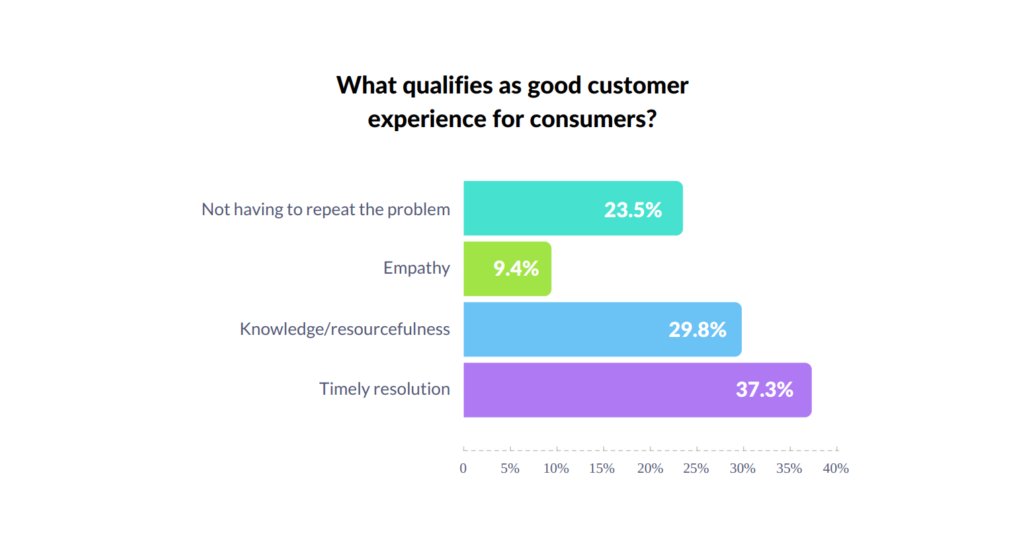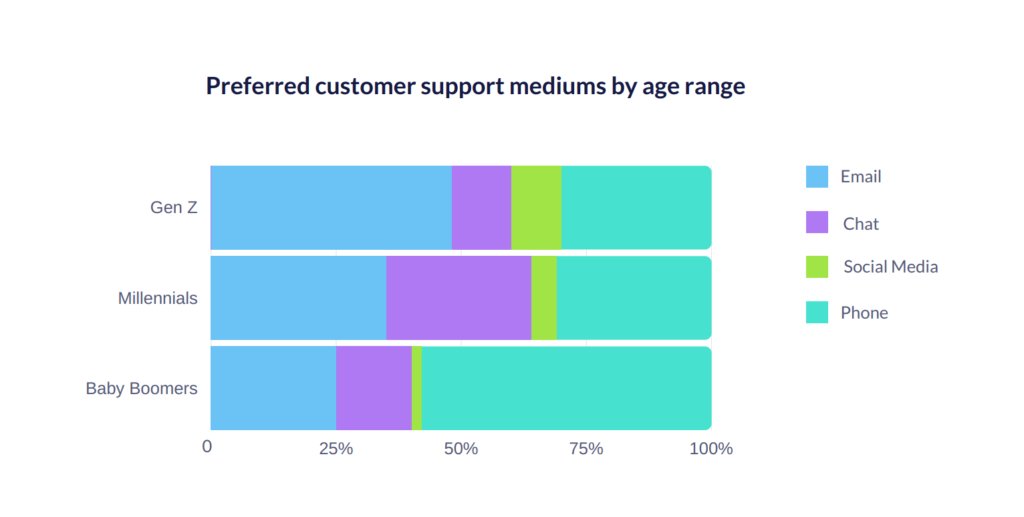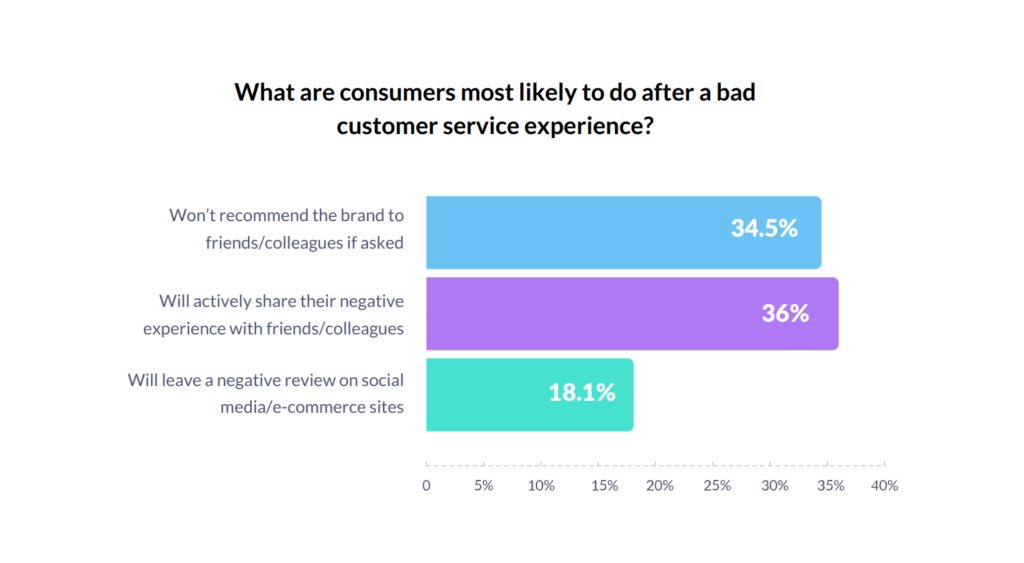We all know that contact centers play an important role in helping companies deliver on-time customer support.
But, what’s really interesting is the impact the COVID-19 pandemic has had on their demand.
In 2019, the global cloud contact center as a service (CCaaS) market was valued at $1.07 billion. But owing to the pandemic, the CCaaS market is now projected to expand at a compound annual growth rate (CAGR) of 23.5%, ultimately reaching a predicted $10.8 billion by 2028.
So, why are contact centers on the rise for customer service teams?
One of the main reasons is that customer support has become now one of the biggest deal-breakers or deal-makers for businesses.
Recent statistics show that 47% of consumers switched to a different brand due to poor customer service just within the last year. But 52% of consumers admit they’ve made an additional purchase from a company after a positive customer service experience.
Modern contact centers can help businesses gain a competitive advantage, especially in times where customers are extremely conscious about the brands they purchase from.
In this article, let’s take an in-depth look at why contact centers are growing in popularity and how companies can leverage them effectively.
But first, let’s make sure we’re all on the same page about what a contact center is.
Table of Contents
- What is a Contact Center or Contact Center as a Service (CCaaS)?
- 5 reasons why Contact Centers are on the rise for Customer Service Teams
- 1. Contact Centers help meet increasing demands on support teams created by the COVID-19 pandemic
- 2. Contact Centers help improve Agent Performance and Productivity
- 3. Contact Centers diversify support channels
- 4. Contact Centers integrate with your organization’s other key technologies
- 5. Contact Centers deliver better Reporting and Analytics, so your team can keep improving
- Wrapping Up
What is a Contact Center or Contact Center as a Service (CCaaS)?
In a call center agents typically only handle voice calls. But in a contact center, agents can serve customers across many types of communication channels.
This omnichannel solution lets people connect to your brand via voice calls, email, SMS, live chat, social media direct message (DM),and more. It then routes customer queries from multiple channels into a centralized system.
And as those customer service statistics mentioned earlier show:
- 57% of customers would rather contact companies via digital media (such as email) than call customer support.
- 33% of customers have contacted a company using Facebook, Twitter, and similar social channels.
- Nearly 1/3 of customers report sending a mobile/SMS message to a company requesting help.
- A whopping 66% of respondents say they’ve used at least three different customer communication channels to contact customer service.
So businesses must meet their customers everywhere they wish to engage; they should tap multiple touchpoints along the customer journey. And to do that effectively, investing in a contact center becomes even more important.
Organizations can create contact centers on-premise or remotely. Or they can even link up with a Contact Center Software as a Service (CCaaS) provider, which may be more cost-efficient.
5 reasons why Contact Centers are on the rise for Customer Service Teams
Recent customer service statistics reveal that 46% of global contact center decision-makers project their contact centers to grow 5-10% in the next year. And 14% of them project growth of more than 10%.
Here’s why contact centers are the hottest thing in customer service since caller ID:
1. Contact Centers help meet increasing demands on support teams created by the COVID-19 pandemic
COVID-19 has altered much of our lives and continues to impact it in many unexpected ways. One of its prominent second-order effects was the increasing demands on customer support teams over the world.
Here are some astonishing stats that show the kind of impact COVID-19 has had on contact centers:
- The early stages of the pandemic brought about an increase of 300% in incoming call volume than usual.
- Average Handle Time (AHT) increased from 3-6 minutes for most contact centers to closer to 10+ minutes.
- Long queue times lead to higher than average Abandon Rates (AR),or how long it takes customers to hang up/leave a conversation without a resolution. As a result, target ARs are likely to rise from 2% to over 10%.
AHT and AR directly relate to customer satisfaction. Most consumers, in fact, rank a timely resolution as the number one trait of a positive customer experience.

When your customers have to wait around to receive an answer, there’s a high possibility that they’ll switch to your competition. And statistics show that 39% of customers will avoid a company for two years after a bad customer service experience.
What’s even worse is that the average American tells 15 people when they’ve had a poor customer service experience. These negative reviews could go a long way in destroying your company’s reputation.
With more people buying goods online rather than in-store, organizations will need to smartly invest in support solutions to stay on top of customer demands.
2. Contact Centers help improve Agent Performance and Productivity
In Hiver’s exclusive research, we learned that 80% of consumers expected better customer service during and after the COVID-19 pandemic. And 32% said they want customer service to be more responsive and empathetic.
However, this demand for better customer support could put a lot of pressure on agents. So, a contact center can help give teams the tools they need to provide the best experiences possible.
Contact center solutions that use chatbots, artificial intelligence (AI),and other automation techniques come to mind.
A solution like Hiver, for instance, helps teams automate everyday repetitive tasks, making it easier for them to focus on more important tasks.
An intelligent virtual assistant (IVA),for example, delivers answers to common questions and solves customer problems quickly — often the first time they reach out. It’s like an interactive FAQ chatbot.
The quicker you respond to customer inquiries or problems, the happier they will be. This also makes customers less likely to churn. After all, researchers discovered that customer-centric companies are 60% more profitable than companies that don’t focus on customers.
3. Contact Centers diversify support channels
Contact centers unify your voice calls, email, SMS, webchat, video, and social media support channels. This allows contact center agents to connect with customers wherever and whenever they reach out, using a single platform.
In Hiver’s Customer Service Benchmark Report (2021), we learned that 60% of modern brands offer support on at least three channels. Phone and email support still dominate the pack. But chat, social media, and self-service are in a tight race for third place.

These days, stats show that 90% of consumers expect an online portal for support. Most people want to find a solution on their own before contacting support teams. However, preferred channel use also depends on the age of your customers:

Gen Z and Millennials prefer digital channels like email, chat, and social media over phone support. But Boomers still prefer phone calls. A contact center allows your team to reach everyone, no matter the channel. And your contact center metrics (NPS & CSAT) will clue you into your customers’ most used channels (more on this later!).
4. Contact Centers integrate with your organization’s other key technologies
A staggering 72% of consumers say that when contacting customer service, they expect the agent to “know who they are, what they have purchased, and have insights into their previous engagements.”
That’s why having your contact center integrate with your phone system, customer relationship management technology (CRM) and other tools is important. This gives your support agents a more holistic understanding of present and prospective customer needs, expectations and behaviors.
Then you can use this customer data to help your team do their jobs more effectively. It may also reduce how long it takes to provide support.
5. Contact Centers deliver better Reporting and Analytics, so your team can keep improving
Contact center analytics don’t just give you a better view of your support metrics. They also highlight opportunities or pain points in the support process. Identify these, and you can improve your contact center’s performance and customer satisfaction scores.
For example, your analytics may indicate that your customers prefer email support over phone calls. If you run with this customer service trend, you may want to add more agents to handle customer interactions over email.
You can also see which agents are thriving and which of them need more training.
If you don’t track and monitor these stats, you’ll never know where your team needs help. And that could eventually lead to poor customer service experiences, negative online reviews, and high customer churn.

Attracting a new customer is 6-7 times more expensive than retaining a current one.
But here’s the good news: 67% of customer churn is preventable if customer service resolves issues the first time they occur. And just a 5% increase in customer retention can generate 25% more profit!
So when you consider the cost of acquiring a new customer, you’ll see that keeping your customers happy is a much better strategy. And your support team could make all the difference in whether your company thrives or struggles.
Wrapping Up
It’s no surprise that contact centers are on the rise for customer service teams. COVID-19 raised customer expectations and put a strain on support availability.
But contact center solutions can help optimize agent efficiency and meet support demands better. They also allow teams to offer multichannel support and improve customer engagement.
Plus, when your contact center integrates with a Gmail-based Helpdesk, your agents can deliver personalized service the easy way.
And that’s the cornerstone of greater customer loyalty.
Resources you’ll love:
- Difference between call centers and contact centers by Twilio
- NoJitter’s article on how contact centers turn employees into agents
- Lifesize’s post on Contact Center Best Practices
- Contact Center Trends for 2022
- Gartner’s post on customer loneliness as a contact center call driver


































